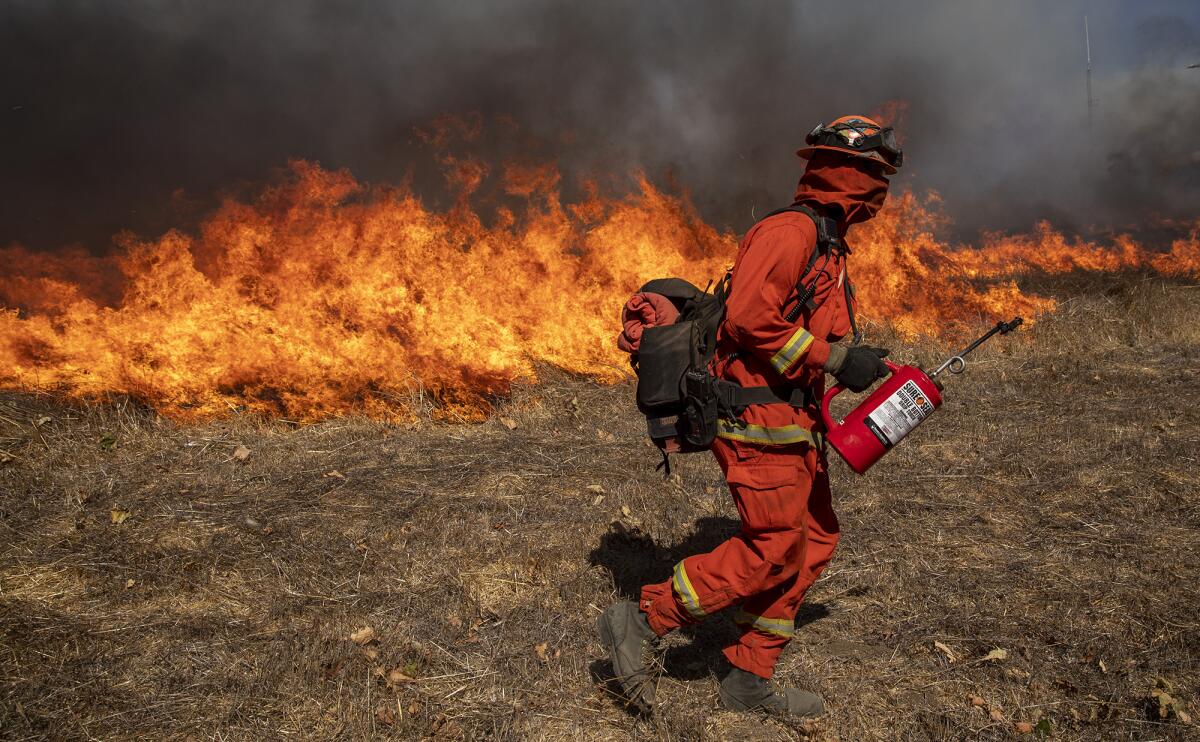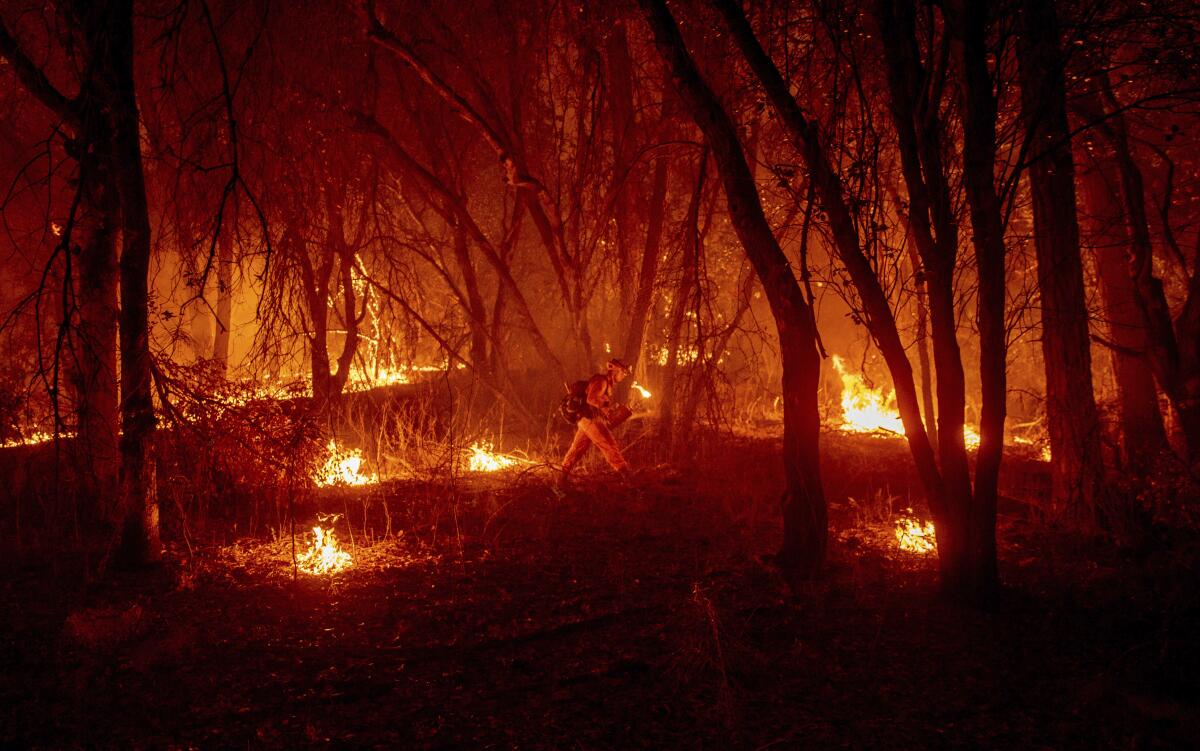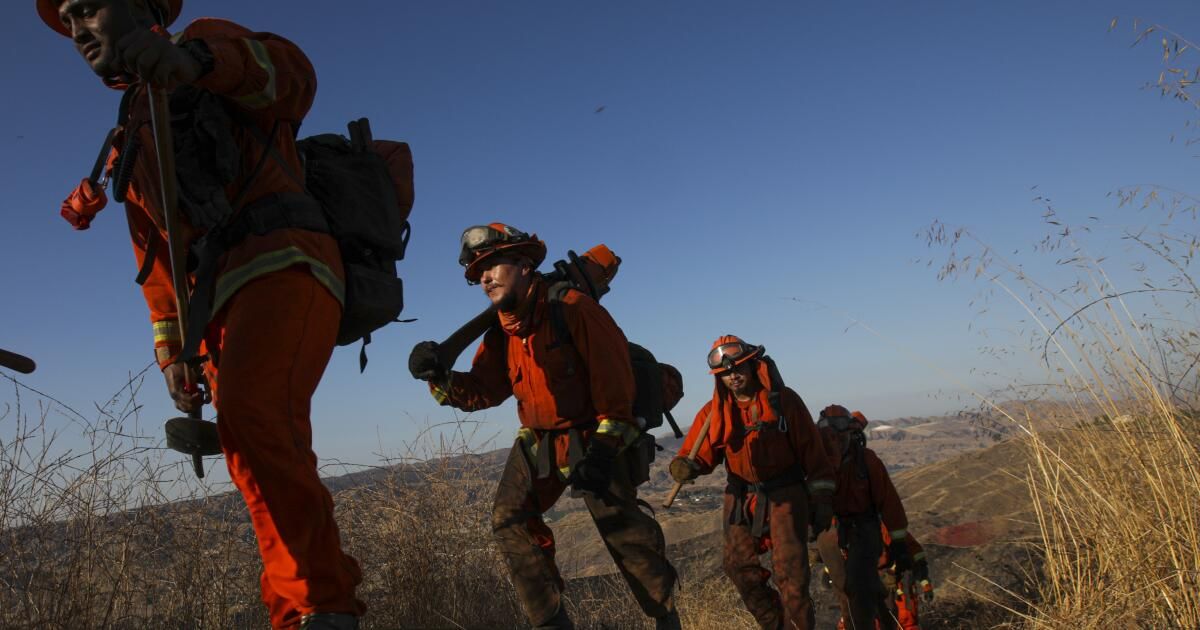Two wet winters followed by repeated record-breaking heat waves in recent months have put California on track for a scorching summer.
And while California Department of Forestry and Fire Protection firefighters will be on the front lines against the flames, behind them in the trenches are hundreds of California inmates, digging, hacking and chainsawing through containment lines to give crews a head start. And there are fewer of them than ever.
Spread across the state's 35 conservation camps (minimum-security facilities), they conduct crucial fuel reduction projects year-round and occasionally place themselves in the path of advancing flames. cost of their own lives.
But prison reform and the COVID-19 pandemic have reduced the number of inmates who can attend camps — run by the California Department of Corrections and Rehabilitation, Cal Fire or the Los Angeles County Fire Department — for firefighting training and duties. At the same time that camp sizes have shrunk — from a peak of 4,250 to fewer than 1,800 today — California has suffered its largest and deadliest wildfires, and this summer is off to a bad start.
Still, Cal Fire and state prison officials say their strategy of using younger inmates, relying on seasonal crews for longer periods of time and partnering with the California Conservation Corps and the California Military Department will help them get through the year and eventually get the number of inmate firefighters back to pre-pandemic levels.
“I know there have been other articles that have painted a picture of doom and gloom and despair,” said Jarrod Clinkenbeard, chief of staff for Cal Fire’s fire equipment program. “I don’t think that’s the current situation.”
A team of inmate firefighters put out the Kanan Fire in Agoura Hills last July.
(Brian van der Brug/Los Angeles Times)
In 2005, at the height of the inmate firefighting program, officially known as the Conservation (Fire) Camp Program, there were 192 crews, or 4,250 inmate firefighters, according to the state Department of Corrections. Program participants include support staff such as cooks, orderlies and maintenance workers. Four years ago, as prisons closed and the inmate population declined, the Department of Corrections reduced the camps to 1,821 participants. As of July 2, there were about 83 hand crews, or 1,760 participants.
Depending on the year, inmate fire crews make up as much as 30 percent of the state’s fire force and are typically paid between $5.80 and $10.24 per day by the Department of Corrections, with an additional dollar per hour from Cal Fire when responding to a disaster. Inmate fire crews are comprised of 12 to 17 firefighters, led by a fire captain. Inmates who have been convicted of violent crimes — such as rape, lewd acts with a child under 14, or any felony punishable by death or life in prison — or who have a history of escape or arson are automatically disqualified.
In a June 21 letter to Gov. Gavin Newsom, Los Angeles County Supervisors Lindsey Horvath and Kathryn Barger expressed concerns about deeper cuts to the program that would have closed five camps in the county, affecting more than 200 inmate firefighters.
“The consequences of these cuts are dire,” the letter reads in part. “As you know, California is facing a severe shortage of wildfire equipment, a situation that has been exacerbated by the increasing frequency and severity of wildfires due to climate change.”
In fact, the loss of manual crews has occurred across the country, but the labor crisis is particularly acute in California, where 14 of the 15 largest fires on record have occurred since 2007. This year, the state has seen 90,000 acres burn, significantly more than average at this point in the season.

Inmate crews set fires in thick brush near Thousand Oaks in 2019.
(Brian van der Brug/Los Angeles Times)
The governor recently removed all five of Los Angeles County’s fire camps from his list of cuts this year, as Horvath and Barger had requested, but other efforts to increase firefighting by inmates have been in the works for months or years.
In August, the corrections department launched the Juvenile Offender Conservation Camp Program, a pilot program that allows eligible incarcerated young adults to become firefighters and is set to expire next year unless it is made permanent.
The program is an offshoot of the Department of Corrections’ Juvenile Offender Program established in 2014 and allows eligible inmates ages 18 to 25 to receive fire training before being housed at the Growlersburg Conservation Camp in Georgetown, a mountain community northeast of Sacramento.
All inmate firefighters receive the same training that seasonal wildland firefighters receive, which includes one week of classroom instruction and one week of field exercises. Once inmates graduate from the program, they are eligible to be placed in a camp.
Currently, there are 113 volunteers at the Growlersburg camp. Of those, 30 are part of the pilot program and 18 are inmates who are certified mentors. The young adult firefighters responded to their first fire on May 10 in El Dorado County.
Corrections officials said the program is showing promising results and that the number of manual crews could slowly return to 2019 levels, when there were 1,975 inmate firefighters and support staff at the department's fire camps.

An inmate firefighter at Trinity River Conservation Camp uses a drip torch to stop a wildfire burning north of Redding in 2021.
(Ethan Swope/Associated Press)
It took California years to get to this point, and it will take years to find a reliable solution, officials said.
Hand-cranked haircuts have come in waves as penalties for some crimes have been reduced, Clinkenbeard said. The first wave came in 2011 with California's reorganization law that required some nonviolent inmates to serve time in county jails instead of prisons.
Then, in 2014, Californians passed Proposition 47, which allowed courts to reduce penalties for some nonviolent robbery and drug possession offenses that were reclassified as misdemeanors.
Three years later, voters approved Proposition 57, which allowed inmates convicted of nonviolent crimes to be considered for early release or parole.
In 2020, the pandemic prompted the state to release more inmates to allow for greater distancing between those behind bars.
Two years ago, the California Correctional Facility in Susanville, which also serves as a firefighter training center for inmates, closed. Another is expected to close. next year.
Despite the reductions, Clinkenbeard said, Cal Fire still has a healthy number of fire crews for the fire season. He said the agency also has mutual aid agreements with other states that it can draw on to help bolster its firefighting force.
As of July 2, Cal Fire had 149 manual crews, 65 of which were state inmate crews; 38 were seasonal firefighters, 32 were California Conservation Corps participants, and 14 were California Military Defense.












